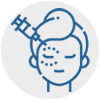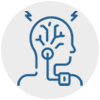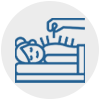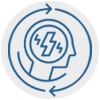Explore this page:

What is Acupuncture?
Acupuncture is an ancient medical practice based on traditional Chinese medicine, and is widely used around the world to treat a variety of medical conditions. It is considered to be a complementary medicine practice, and involves the insertion of fine needles through the skin at specific points of the body with the intention of restoring the balance and the flow of Qi (which is pronounced as “chi”) energy.
Acupuncture is considered to be an alternative medical practice, based on traditional Chinese medicine, and the theory that the complementary “yin” and “yang” forces of the Qi energy need to be in a state of equilibrium in order for each individual to be healthy.
Qi is believed to flow across the body through “meridians”, or pathways of energy flows, which are accessible through hundreds of acupuncture points in the human body.
According to traditional Chinese medicine, inserting fine filiform needles at these acupuncture points can help to restore the energy flow throughout the body. Typically, acupuncture points are located where nerves enter a muscle, at joints, or at midpoints of muscles.
The use of acupuncture has been steadily gaining popularity in many Western countries. One of the main benefits of acupuncture is that it can provide effective results without causing the side effects associated with prescription medication. The effects of acupuncture can be long-lasting (for up to 6 months).
How does acupuncture work?
From a scientific point of view, it is thought that acupuncture stimulates nerves, muscles and connective tissue, which relaxes muscles, increases blood flow to the stimulated area and triggers the release of enkephalins and endorphins, which act the body’s natural painkillers. Scientific studies have also demonstrated that acupuncture affects the central and peripheral neuro-hormonal network.
The course of acupuncture treatment typically involves several regular sessions, until the desired effect is achieved. In addition to performing traditional Chinese medicine techniques, acupuncture practitioners can also provide some advice on additional prescription herbal treatments, as well as diet, exercise, and any necessary life style modifications for the patient.
When is acupuncture used?
Acupuncture can be used alone or in conjunction with other therapies, including more conventional methods. Numerous scientific research studies have demonstrated that acupuncture can help to alleviate pain, including chronic low-back pain, neck pain, as well as osteoarthritis and knee pain. In addition, studies have also shown that acupuncture can be used to decrease the frequency and even prevent tension headaches and migraines.
Most often, acupuncture is used to treat the following conditions:
- Chronic pain, including low back pain
- Headaches, including tension headaches and migraines
- Dental pain
- Menstrual cramps
- Osteoarthritis, including knee osteoarthritis
- Chemotherapy-induced nausea and vomiting
- Stress and anxiety
- Digestive disorders
- Respiratory disorders
- Insomnia
Are there any risks associated with acupuncture?
When practiced by a certified provider, acupuncture is safe and is often perceived as calming and relaxing by the patients. Typically, acupuncture does not hurt, and during the treatment, patients can experience the sensations of mild tingling, heaviness, mild soreness and/or numbness in the stimulated body region. Using large scientific studies, it has been demonstrated that acupuncture is very safe.
However, acupuncture is not recommended for everyone, as some patients may be at an increased risk for side effects, including individuals who have bleeding disorders, have a pacemaker, or pregnant women. Some common side effects of acupuncture include minor bruising, bleeding and soreness at needle insertion sites. Typically, upon the completion of an acupuncture session, the patient feels relaxed and energized.
Types of Acupuncture
Body acupuncture:
This is the most common type of acupuncture, and involves the insertion of fine filiform needles, typically made of steel (but sometimes made of silver or gold), into specific acupuncture points on the body. Because these needles are solid and very small in diameter, little pain and discomfort is felt upon insertion. Body acupuncture is used to treat arthritis, chronic fatigue, chronic pain, and migraines.
Moxibustion:
This acupuncture technique involves the application of indirect heat using traditional spongy therapeutic herbs (referred to as moxa), or with heat lamps (or sometimes using a combination of both) to heat specific trigger points and achieve muscle relaxation, and improve the flow of Qi. Moxibustion is often applied to treat colds, arthritis, digestive problems and arthritis.
Electro-acupuncture:
This technique involves the application of low-frequency electrical current of about 1Hz to the acupuncture needle upon inserting, with the goal of relaxing muscle tissue and clearing accumulated Qi energy.
Cupping:
Glass suction “cups” are applied to the surface of the skin when the body’s Qi energy is considered to be blocked in order to draw it to the body’ surface. Cupping is meant to relieve muscle and skin inflammation, improve the blood flow, and relax the nervous system. This technique is often used to treat eczema, muscular pain, headaches, colds, and arthritis. Often, the cupping technique is used in conjunction with body acupuncture, but can also be used alone.
Auricular acupuncture:
This acupuncture method involves using the acupuncture points located in the ear, which, according to traditional Chinese medicine, are believed to represent all other areas of the body. Very fine needles, or ear “seeds” or tacks are used to stimulate ear acupuncture points. This method is typically used in conjunction with other acupuncture styles, and can be used to treat infertility, allergies, mood disorders, and addictions, including smoking and alcohol abuse.
Acupressure:
This method is based on applying pressure and massaging acupuncture points in order to increase muscle relaxation and enhance blood circulation in the body region being treated. Acupressure can be very effective in treating muscle and back pain, and is also often used in treatment of morning sickness.
Tui-na:
This technique combines the use of acupuncture, therapeutic massage and other forms of body manipulation in order to achieve muscle relaxation. Tui-na is often used to treat superficial trauma and injury, as well as a variety of musculoskeletal problems.
Conclusion
Acupuncture is a safe alternative medical practice rooted in traditional Chinese medicine. When practiced by a certified acupuncture practitioner, acupuncture is considered to be very safe and can help to treat a variety of medical conditions, including chronic back and neck pain, knee osteoarthritis, migraines, and anxiety.
Due to the low risk of the procedure, it can be recommended for patients for whom standard medical care has been ineffective. The short- and long-term benefits of acupuncture, combined with the low risk associated with its practice, make this technique a viable and versatile option for the treatment of many medical conditions.
The First Steps
There are many conditions that Acupuncture can help with, but only when you take the first step and visit a specialist who knows just how acupuncture can help to balance out your body energy.
Contact our friendly staff at the Headache, Migraine & Concussion Centre today to learn how we can help to relieve your body of pain and get back to enjoying your life. Contact us to schedule your appointment.






